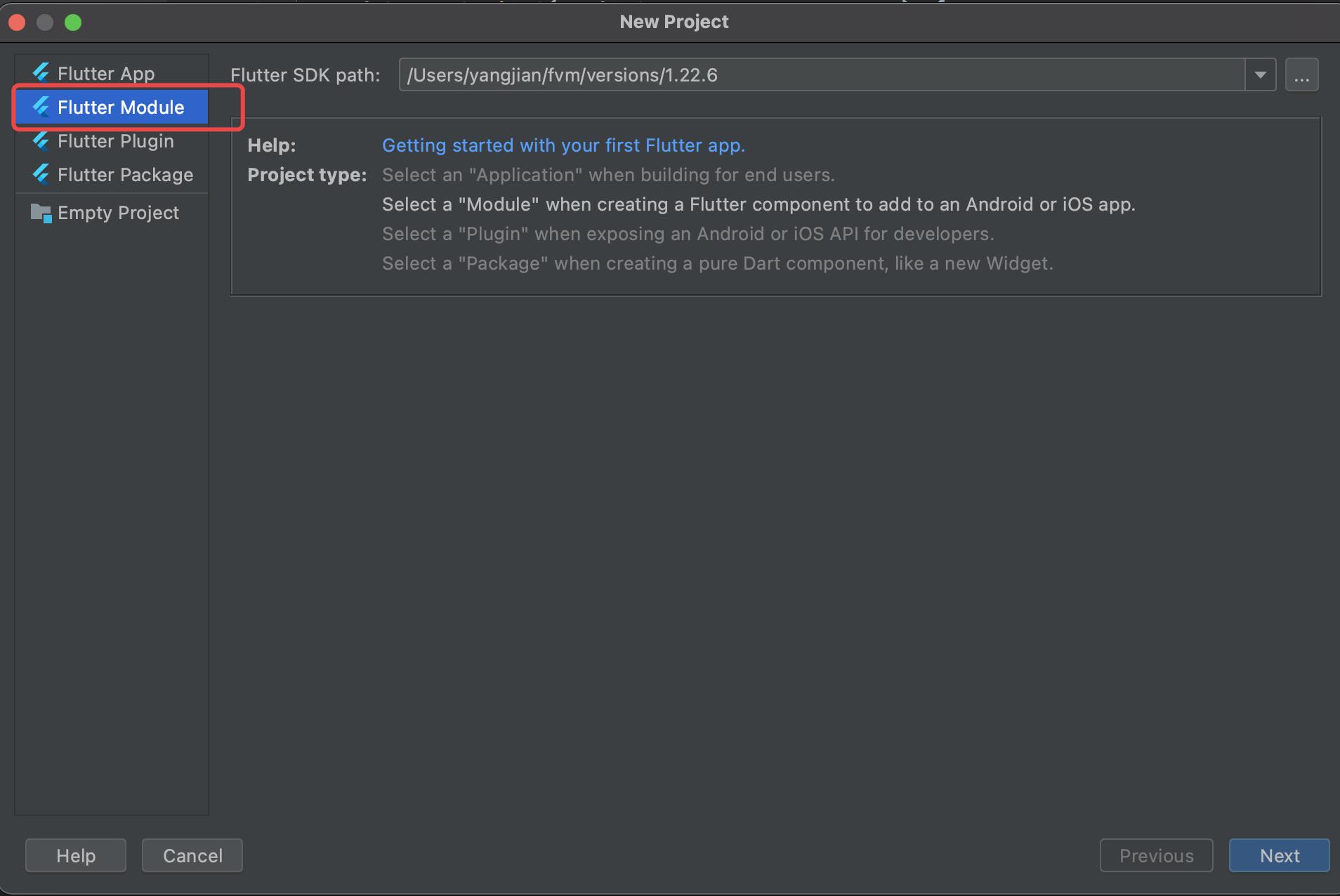ios原生嵌套Flutter模块
Posted
tags:
篇首语:本文由小常识网(cha138.com)小编为大家整理,主要介绍了ios原生嵌套Flutter模块相关的知识,希望对你有一定的参考价值。
参考技术A 通过以下命令解决执行完毕后,Flutter module将会创建在ios项目/my_flutter目录下
将Flutter模块嵌入到现有iOS应用程序中有两种方式:
此方法需要所有的相关开发的人员安装 Flutter 环境。
需要在my_flutter文件夹下执行一下
把.ios和.android等flutter配置生成出来。
AppDelegate.h:
AppDelegate.m:
控制器:
flutter:
注册路由
通过全局FlutterEngine实例化FlutterViewController,并setInitialRoute设置初始化路由,这里发现设置的初始化路由路由并不管用
控制器:
设置FlutterViewController的pushRoute
这里其实只是让flutter方面push一次
新建一个FlutterViewController并把setInitialRoute设置为跳转的路由,不通过全局的FlutterEngine创建
放一个之前自己学习时写的demo,希望可以帮助新入门的老铁们,有好的建议可以提一下,我们一起进步,奥利给!!!
https://github.com/Baffin-HSL/Flutter_UI
原生(iOS)与Flutter混合开发步骤
一、前言:目前混合开发属于主流,因为多数都在原来的项目上集成Flutter模块,除非新的项目用纯Flutter,那是挺爽的。混合开发多数会有点坑吧。现在记录下混合开发的坑
二、集成(以iOS为例),使用Pods方式
1、首先创建一个Flutter模块(非Flutter项目,是模块)

2、创建后之后,把原生项目和Flutter模块放在一个文件夹下,同一层级。

3、原生项目打开Podfile,加入Flutter,如下
// my_flutter 是创建Flutter的模块名称
flutter_application_path = '../my_flutter'
load File.join(flutter_application_path, '.ios', 'Flutter', 'podhelper.rb')
platform :ios, '9.0'
target 'NativeIOS' do
use_frameworks!
/// 这边引入
install_all_flutter_pods(flutter_application_path)
/// 其他
...
end
4、在原生目录下,pod install,在pod install之前,先在Flutter模块下执行 flutter pub get
4.1、 Flutter模块下 执行 flutter pub get
4.2、 在原生项目下 执行 pod install
如果以上不报错,混合开发模式到这里就集成完了。,可以好好的玩耍了。不过好像想的有点多…
5、Flutter模块那边怎么写还是怎么写,Flutter模块也是可以跑起来的。
6、在原生项目中注册Flutter引擎, 就是flutterEngine。 在启动的时候就注册,这样后续就不会出现卡顿的样式,有点儿难受。
/// 在AppDelegate入口初始化即可
#pragma mark - initFlutterEngine
- (void)initFlutterEngine {
self.flutterEngine = [[FlutterEngine alloc] initWithName:@"WMFlutterEngine"];
[self.flutterEngine run];
[GeneratedPluginRegistrant registerWithRegistry:self.flutterEngine];
}
/// 修改如下改成 FlutterEngine
@interface AppDelegate : FlutterEngine
7、在原先项目需要跳转的地方写业务即可了。
/// 某个原生控制器
// testPushFlutterPage 跳转的地方 ,其中self.flutterVC 是我单独的一个类 见8
/// 跳转到Flutter页面。
- (void)testPushFlutterPage {
self.flutterVC.fd_prefersNavigationBarHidden = YES;
[self showViewController:self.flutterVC sender:nil];
}
- (void)initMethodChannel {
self.flutterVC = [[WMFlutterViewController alloc] init];
[self.flutterVC initMethodChannel];
}
- (void)viewDidLoad {
[super viewDidLoad];
[self initMethodChannel];
}
8、flutterVC类
#pragma mark - Initial Methods // 初始化的方法
- (instancetype)init
{
self = [super init];
if (self) {
self = [[WMFlutterViewController alloc] initWithEngine:[self getFlutterEngine] nibName:nil bundle:nil];
}
return self;
}
//
- (void)initMethodChannel {
FlutterMethodChannel *methodChannel = [FlutterMethodChannel methodChannelWithName:@"PatientSearchChannel" binaryMessenger:self.binaryMessenger];
self.methodChannel = methodChannel;
//通过block回调监听通道中来自flutter的消息体 这里做一个dismiss方法,由于iOS中将flutter页面push出来,次数实现dismiss方法,给flutter发送dismss消息,就知道是让iOS将当前页面关闭的动作,iOS收到后,执行关闭操作
__weak typeof(self) weakself = self;
[methodChannel setMethodCallHandler:^(FlutterMethodCall * _Nonnull call, FlutterResult _Nonnull result) {
__strong typeof(weakself) strongself = weakself;
//dissmiss当前页面
if([call.method isEqualToString:@"dismiss"]){
// [strongself.flutterVC dismissViewControllerAnimated:YES completion:nil];
[strongself.navigationController popViewControllerAnimated:YES];
}
if (result) {
result(@"回到的地方");
}
//dissmiss当前页面
if([call.method isEqualToString:@"pushNative"]){
WMLog(@"pushNative 进来了 数据是 %@", call.arguments);
WMNoticeSetViewController *VC = [[WMNoticeSetViewController alloc] init];
WMLog(@"%@", self .navigationController);
[self.navigationController pushViewController:VC animated:YES];
}
//dissmiss当前页面
if([call.method isEqualToString:@"pushNativeTwo"]){
WMLog(@"pushNativeTwo 进来了 数据是 %@", call.arguments);
NSDictionary *dataDic = call.arguments;
WMTestViewController *VC = [[WMTestViewController alloc] init];
VC.name = dataDic[@"name"];
WMLog(@"%@", self.navigationController);
[self.navigationController pushViewController:VC animated:YES];
}
}];
}
/// 获取引擎
- (FlutterEngine *)getFlutterEngine {
FlutterEngine *flutterEngine = ((AppDelegate *)UIApplication.sharedApplication.delegate).flutterEngine;
return flutterEngine;
}
以后原生部分就写完了。
9、Flutter部分,我写了一个工具类,来和原生交互的类
class NativeChannelUtils {
static const MethodChannel _patientSearchChannel =
MethodChannel('PatientSearchChannel');
/// 患者搜索关闭
static patientSearchDismiss({WMValueCallBack valueCallBack}) {
_patientSearchChannel.invokeMethod("dismiss").then((value) {
Utils.logs('回来的数据 = ${value}');
if (valueCallBack != null) {
valueCallBack(value);
}
});
}
/// 患者搜索到原生界面
static patientSearchPushToNative({WMValueCallBack valueCallBack}) {
_patientSearchChannel.invokeMethod(
"pushNative", {"data": "我是Flutter数据", 'code': '1000'}).then((value) {
Utils.logs('回来的数据 = ${value}');
if (valueCallBack != null) {
valueCallBack(value);
}
});
}
/// 患者搜索到原生界面
static patientSearchPushToNativeTwo(
{Map arguments, WMValueCallBack valueCallBack}) {
_patientSearchChannel
.invokeMethod("pushNativeTwo", arguments)
.then((value) {
Utils.logs('回来的数据 = ${value}');
if (valueCallBack != null) {
valueCallBack(value);
}
});
}
}
在Flutter需要的地方调用。
NativeChannelUtils.patientSearchDismiss(valueCallBack: (value) {
Utils.logs("哈哈哈哈");
});
`
注意点:原生和Flutter交互有三种方式,目前使用的MethodChannel方式
MethodChannel:Flutter 与 Native 端相互调用,调用后可以返回结果,可以 Native 端主动调用,也可以Flutter主动调用,属于双向通信。此方式为最常用的方式, Native 端调用需要在主线程中执行。
BasicMessageChannel:用于使用指定的编解码器对消息进行编码和解码,属于双向通信,可以 Native 端主动调用,也可以Flutter主动调用。
EventChannel:用于数据流(event streams)的通信, Native 端主动发送数据给
这个是Flutter原生方式混合开发。由于是在项目中集成的,后期看下 提出demo.
这边我用闲鱼的flutter_boost 混合开发方案 写了一个demo。
demo地址:https://github.com/yj229201093/NavateFlutterDemo
但总觉得和自己想要的差一点点东西。所以目前采用原生方式混合开发。
注意:如果使用原生方式,尽量不要开多个引擎,不然开销很大,就是:下面就开启了两个引擎。Flutter引擎是相互独立的。互不干扰的。
原生A->FlutterB,
FlutterB->FlutterC,
FlutterC->原生D,
原生D->FlutterE
建议是一个闭环开发,一个项目开启一个Flutter引擎。就是原生进入Flutter模块,然后Flutter模块结束后就回到原生,这样算一个闭环。
如果反复跳转可以使用闲鱼的flutter_boost方案。
后续可能采用flutter_boost方案。目前导航栏方便还有点没有理清。
以上是关于ios原生嵌套Flutter模块的主要内容,如果未能解决你的问题,请参考以下文章